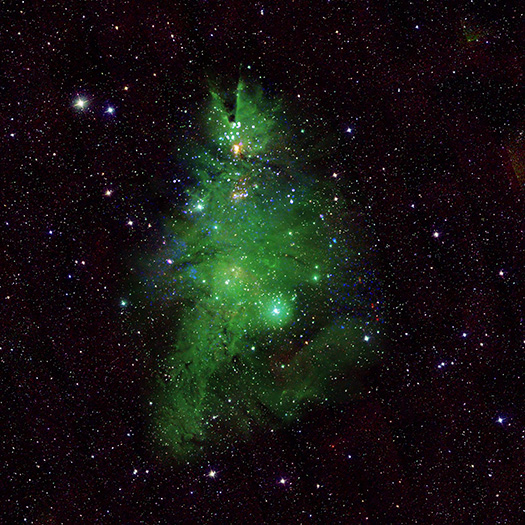Watch the 'Christmas Tree Cluster' twinkle in X-rays (video)
A cosmic christmas tree appears to sit some 2,500 light-years from Earth.
This month, space feels a bit more festive.
That could be because of a new composite image of the Christmas Tree Cluster that shows star formation in a merry way, complete with green pine needles and twinkling lights. This image, in fact, arrives to our computer screens just after we laid eyes on the James Webb Space Telescope's cosmic Christmas ornament portrait and shortly before the Hubble Space Telescope released its version of a Christmas "globe."
But returning to the tree, various wavelengths and telescopes were used to create the image. The gas is seen in the optical category, lit up in green from observations from the WIYN Observatory. Foreground and background stars, shown in white, were imaged in the infrared with the Two Micron All Sky Survey, or 2MASS. But what really makes this tree twinkle are aspects of the image provided by Chandra. This data shows actual stars in X-Ray wavelengths, which blink in blue and white in the animated image below.
These stars really do "blink" (although not in the coordinated way shown). The young stars, only about 1 to 5 million years old, undergo dramatic variations in brightness. Sometimes, this results from a star's rotation. As a star turns, hot spots or dark regions pop in and out of view, making it appear that the star is changing brightness. Other times, the variation in brightness may have nothing to do with the star itself but rather originate from the disk that surrounds it, which may periodically obscure the amount of starlight we see.
But perhaps in the most interesting case, the variations in brightness may originate from magnetic fields. Besides creating star spots, such fields can create powerful stellar flares. Young stars, for instance, are known to be able to emit violent X-ray flares. While we can't directly resolve these flares like we can with our sun's, we can see their effects by the overall change in brightness of the star. Flares like these are much more energetic and frequent than what we see with our sun.
Because the stars in this pine tree-esque image are so young, they also still may be forming their own stellar systems. Those flares, however, can have dramatic consequences for planets forming in the disk surrounding these stars. Flares can be powerful enough to partially evaporate planets.
But the news isn’t all bad.
Breaking space news, the latest updates on rocket launches, skywatching events and more!
Flares can lead to turbulence in the disk surrounding these stars, which may prevent small, rocky planets from migrating inward toward their parent star too quickly.
The Christmas Tree Cluster is part of NGC 2264 and is 2,500 light-years from Earth. Stars in this cluster range in mass from about 7 to 0.1 times the mass of our sun.

Elizabeth is a freelance science writer. She has a Ph.D. in astrophysics from the University of Texas at Austin and has worked with telescopes all around the world and in space. Now she writes on astronomy, physics, geology, mathematics, and science and technology in society.

